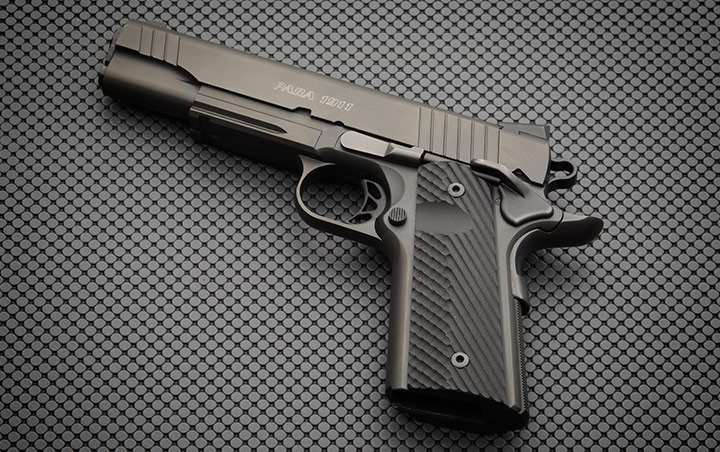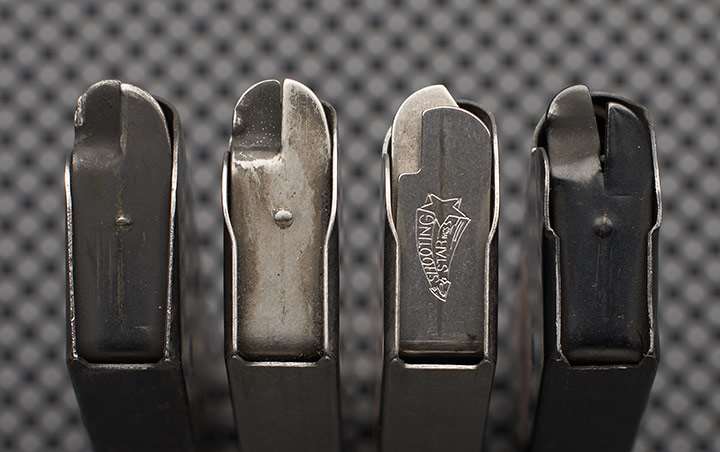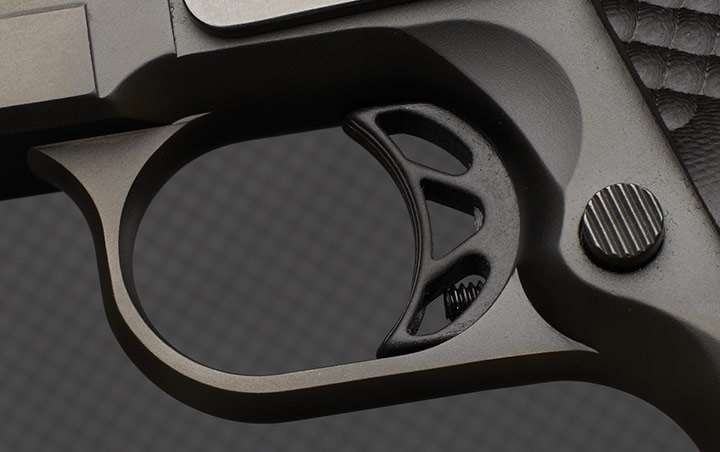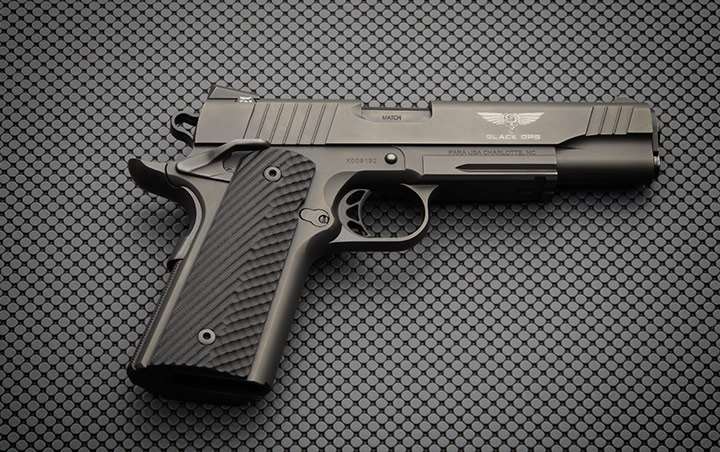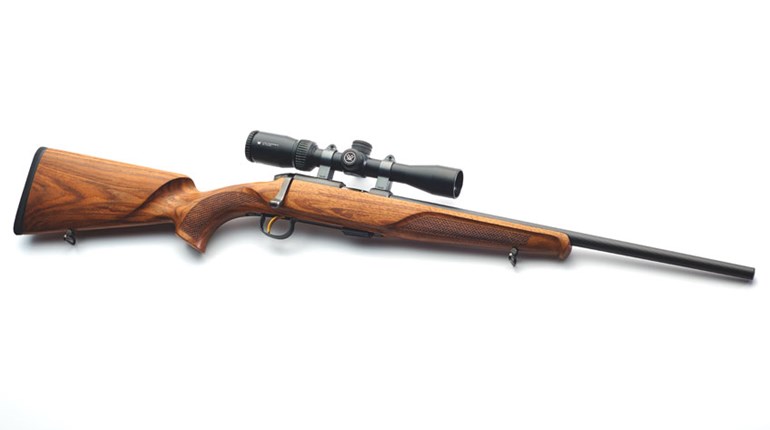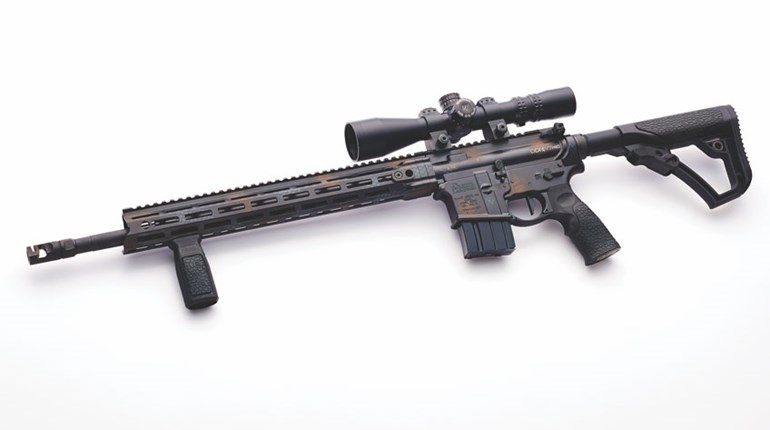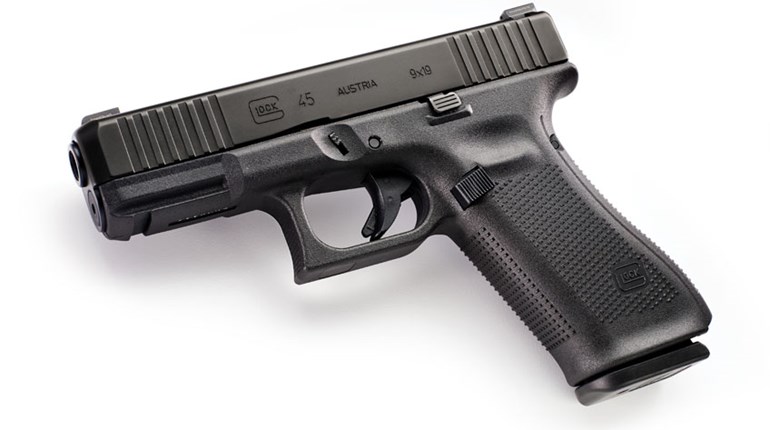
Pistols on John Moses Browning’s 1911 pattern rarely need an introduction. Classic? Without a doubt. Effective? Beyond question. There is— particularly after 102 years—a variation for every taste and application.
It is precisely this variety and versatility that begged a question in our minds: Why another, single stack, 5”, .45 ACP on Browning’s timeless design?
Turns out William Smalley, Para’s production manager, had a good answer.
“As remarkable as the original design is, it can benefit from new tools and technology,” Smalley said. “We’ve spent considerable resources in our focus to create a line of hard-use pistols. We are reclaiming the high ground and building the best products in our history and the best 1911 among our peers. The company that Ted and Thanos started was known for quality and innovation. We felt by dropping some of our in-house processes that we deemed sub-par, Pineville could surpass those pistols built during the halcyon days. The partnerships we have struck with manufacturers such as EGW, VZ and Ionbond are showing positive results, like the Black Ops.”
The Pistol
The Black Ops is built in Para’s North Carolina facility. The frame and slide are forged, with a match-grade, Para-ramped, loaded chamber indicator-notched barrel. A full-length guide rod mates with a conventional bushing assembly to complete the front-end lockup.
All-dovetailed, dehorned Trijicon three dot/tritium night sights crown the flat-top slide. The frame sports a flat backstrap/ mainspring housing under an ample beavertail/grip safety. Skeletonized hammer and a mid-length overtravel adjustable trigger are mated with an ambidextrous safety and VZ G-10 “Operator” grips. Other touches include forward cocking serrations and an integral sight/light rail milled into the frame.
The remainder of the Black Ops’ kit is as it should be: a lockable plastic case that will stand in if you must fly with the pistol, comprehensive owner’s manual and bushing wrench.
The finish on the Black Ops is Ionbond. Smalley gave us a primer: “It has three times the hardness of coatings like Ni-Boron and hard chrome but can run in the absence of lubricant like no other coating we tested and is a mainstay in the aerospace and racing industries.”
As a practical matter, it’s a good-looking deep grey matte and—within the limits of our tests—appears it should hold up very well indeed.
Inside
We asked gunsmith and 1911 expert Gary Kimball to walk us through the pistol before we headed to the range.
“(The) barrel hood fit is closer than most production guns, and barrel-to- bushing fit is good,” Kimball said. “The feed ramp on the barrel is perfectly blended with the feed ramp on the frame and should result in excellent feeding. Headspace is also correct—not too deep. I like the use of the EGW ‘heavy-duty’ extractor, and the absence of any play in the extended ejector.”
Kimball also took some extra time to review tolerance and lock-up trade- offs with us, reprising the correct relationships of bushing to barrel, slide to frame, and barrel feet to slide stop (pin) fit. Overall, the fit of these crucial components is good: too tight portends a finicky thoroughbred with a long break-in cycle and sensitivity to inevitable contaminants and lube state; too loose means disappointing accuracy and unpredictable wear. Kimball said the balance struck in fitting promised very reliable functioning and good accuracy, particularly in the tough operating conditions likely for the Black Ops.
The excellent internal tolerances give crisp action on all controls. 1911 aficionados will want to know that the trigger (~4.75 pounds—more on this later) is of the Series-80 style, with a fourth (firing pin-blocking) safety. The ambi thumb safety, grip/beavertail safety, magazine and slide release all functioned as expected. Recoil and mainspring (hammer) tensions were to spec: 16.5 and 24 pounds respectively. “Overall the Black Ops is an attractive, nicely finished gun that exceeds my expectations. There are many more positives than negatives, and the negatives are minor in nature—easy to correct without great time or expense.”
Kimball also provided us with a short list of improvements, but was careful to note that these are outside what would normally be expected on a production pistol: “Overall the Black Ops is an attractive, nicely finished gun that exceeds my expectations. There are many more positives than negatives, and the negatives are minor in nature—easy to correct without great time or expense.”
At The Range
We prepped the pistol for the range with disassembly, cleaning and a mechanical check (with action-proving dummies) to be sure all was in order. In the case of the Black Ops, the cleaning took a little “doing.” Para had protected the Black Ops well for an unknown period of shipping or pre-sale storage. We followed the lubrication instructions in Para’s manual. In a wetter operational environment, we might run the pistol wetter than Para recommends, and dryer in other environments to prevent the “debris magnet” effect, but this is a matter of taste and experience, and may even vary from pistol to pistol.
Late autumn gave us a breezy day for our first range session. The conditions would have delayed accuracy work in any event, but the chance to do some “burnishing” meant the Black Ops got a workout all the same.
Our warm-up consisted of 50 rounds of ball ammunition (American Eagle 230 gr. round nose). We loaded and fired one round in a magazine, repeated twice. This gives maximum control in case of a (unlikely) lockwork malfunction but also checks all basic functions, including slide lock and last round feeding. Two rounds from each of the factory magazines came next, reconfirming last round feeding, the absence of hammer-follow to the half-cock notch, or doubling—all with no issues of any type.
The next phase of break-in consisted of successively adding a round to the magazine and firing to slide lock, ending with a chambered round on top of a full magazine. Again we experienced no issues at all: 50 “bangs,” and every mag load state tested. We noted that magazine insertion needed a very firm hand when all eight rounds are loaded, but this is typical and tends to disappear as magazine springs receive some usage and take their set. As a precaution, we cleaned and re-inspected the Black Ops at 50 rounds.
My Kingdom For A ... Magazine
Original 1911 magazines were considered disposable, to be dropped on the battlefield after a reload. Civilian and law enforcement adopters of the design did not generally have this luxury. We can also theorize that their magazines were more likely to meet with hard-surface abuse in the course of longer service lives.
Two shortcomings in the original mag design emerged. Still common today, welded bases were and are prone to breakage. More serious, and taking much longer to discover, was the insufficiency of the original feed lip pattern. Long but relatively shallow, the original lip design facilitated easy manufacture and reloading. But over time—and particularly if left fully charged—the lips were prone to fatigue and consequent deformation. This led to out-and-out breakage or bullet pitch and yaw as the round was fed, prematurely slowing the slide with an incorrect ramp collision and resulting in a misfeed. Some early apprehensions about reliability in the 1911 design were in fact magazine issues.
Para overcomes both problems for Black Ops owners with the provided magazines (sourced from Mec-Gar). “Modern” feed lips eliminate the problems at the top of the magazine, and a removable/replaceable polymer base plate not only absorbs shock far better, but also provides for easy magazine maintenance. And Para goes one step further by providing three magazines: many duty and competitive basics can be met right out of the box.
In the longer run, however, even the quantity and excellence of the factory magazines won’t be enough. Or won’t be available. Or ... something. Given the imperatives of duty, it is always wise to know what other options are available and known to work in a given pistol. To that end, phase two of our testing moved to a collection of magazines kept for just this purpose: a vintage (circa 1970—original feed lip design) and Series 80 Colt; a couple of Chip McCormicks (regular Shooting Star and a PowerMag); a Wilson Combat; a mid-80s Pachmayr; a pair of Mec-Gars (8- and 10-round); a Tripp Research (10-round); a Kimber and a couple of after-market who-knows-whats—all in all, 13 magazines. And just in case that didn’t turn out to be enough variation, we had our rogue’s gallery of hard-to-feed bullet shapes available: everything from a needle-nosed 155- grain semi-wadcutter to a soft-nosed 260-grain jacketed hollow-point.
We concede to a little vanity in producing stoppages in 1911s, but had practically no luck with the Para. With the exception of one classically difficult, very short OAL 185-grain Hornady semi-wadcutter, each of the next 150 rounds in varied magazine and bullet combinations worked very well indeed. As is our habit, we ran a reference pistol alongside the Black Ops, repeating all our procedures. (This is to prevent ammunition issues from presenting as pistol problems.) It was useful in this case, as our well-shot reference pistol had trouble with the 185-grain SWC as well, locking up on the misfeed even harder than the Black Ops. Our first range visit ended at 200 rounds.
The Trigger
Trigger variation is storied in the 1911 design: we’ve seen 1.8 to 8 lbs. pulls: just plain gravely, is-this-thing-ever-going-off messes to butter-smooth, thrilling “glass rod” breaks. We’d put the Para in the middle. It is safe and reliable, and should last a long time. We did notice slight improvement in the feel of the trigger over time.
Many purists will attribute the middle ranking as an inherent result of the additional Series-80 safety and parts. They argue this is an intrinsic deficit to a truly excellent “tune” on a 1911 trigger. Kimball assured us this isn’t so, though it demands more of a pistolsmith. Our experience leads us to concur.
Very light, professionally tuned triggers certainly have their place, but duty use is not generally one of them; acquiring the expectation that all triggers will be superb can also become a technique problem. Developing proper trigger control remains the best solution, and we barely escaped with our lives resisting Kimball’s willingness to duty tune the Para for us!
Back To The Range
A second trip to the range was in order after a thorough cleaning and inspection of the Black Ops revealed no causes for concern. This trip occurred on an extremely cold day—high of 11 degrees. While this makes for more difficult shooting between the tendency to shiver and overcome bulky clothing, it provides a good test environment.
This session was less structured than the first, though we continued to range widely through our selection of magazine and ammunition types. The Para performed very well again, producing a single misfeed that we suspected was ammunition-related, and which we could not reproduce. Particularly impressive was the continued smooth cycling; such temperatures often produce balky feeding and function as lubrication degrades. We did pay special attention to that misbehaving 185-grain SWC from the first session to see how the slightly looser Para would now behave: Three full magazines were dumped this time, all without incident.
Our intended accuracy work was again thwarted by conditions, but we had no trouble putting rounds on any target we posted, including snap shots on gongs at 35 yards. To our eye, the Para sights are regulated to point of aim as opposed to six o’clock hold. This is not a problem, and certainly not incorrect, but good to know depending on what your plans are for the pistol.
A good cleaning preceded a third trip to the range, where we (finally!) had a good opportunity to test accuracy in the Black Ops:
| Ammunition | 5-shot | 3-shot | |
| American Eagle 230 gr. JRN (845 fps, 364 ft-lbs.) | 1.915 | 1.156 | |
| Winchester "White Box" 185 gr.JFP (868 fps, 306 ft-lbs.) | 1.925 | 0.971 |
*25 yard, rested, hand-held five-shot groups (each test group had a "called" flyer, which was not scored)
We used two shooters to introduce a little more variability, but the Black Ops continued to perform. Sight regulation had both rounds reintersecting point of aim at 25 yards.
We also did speed work with the pistol in this session. We kept a steady supply of loaded mags with a variety of major power-factor and higher loads (factory) feeding the Para and hammering a plate rack. Even without a tuned trigger and lots of dry- fire, we saw from-the-holster, 6-plate times creep steadily downward, coming to rest in the mid to low 4 sec range at 11 yards. No doubt Para’s Travis Tomasie would run it much faster, but it bodes well for the inherent capabilities of the Black Ops.
It’s important to note that this session took us well over 500 total rounds through the Para, and this is where we believe real-world performance assessment in a 1911 comes to light.
Final Analysis
Simply put, this assessment meant we had both Smalley’s and Kimball’s separate but similar words ringing in our ears: “The balance of tolerances between barrel hood, barrel link and barrel bushing along with slide to frame fit give us accuracy AND the ability to run under more extreme conditions. This is where the Para ramped barrel and Ionbond’s low coefficient of friction really shines.” This was certainly our experience.
The Black Ops is a tough, reliable pistol that really delivers. We shot it in the cold. We shot it dirty. We shot it with dozens of magazine and ammunition combinations. We shot it at 50 yards on 8-inch plates and produced reliable hits when we did our part.
If your department or unit will allow it, or as a personal arm to shadow an issue weapon (you listening, Marines?), the ParaUSA Black Ops deserves a serious look. And yes, we’re stalling in getting this pistol back to Smalley.
Photos by Don Jones

